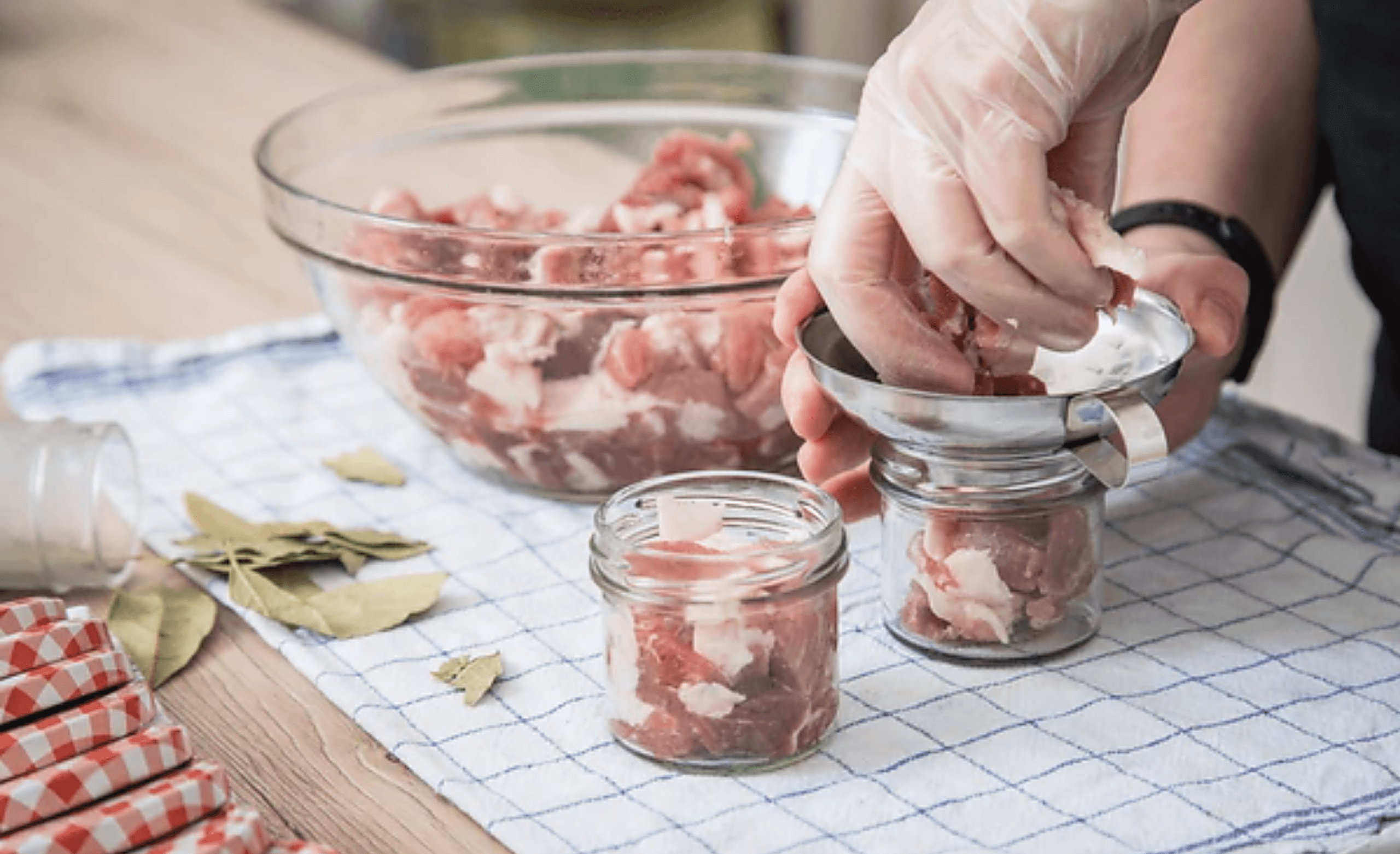
Preserving Meat In Lard
Preserving meat in lard is a time-honored technique that combines practicality with rich flavor. Imagine having tender, succulent pieces of meat stored safely, ready to bring comfort and indulgence to your meals. This method not only extends the shelf life of meat but also infuses it with an irresistible taste that can elevate any dish.
As we delve into the world of preserving meat in lard, we’ll explore its fascinating history and uncover why this age-old preservation technique remains relevant today. Whether you’re a seasoned culinary enthusiast or just starting your journey into food preservation, this guide will equip you with everything you need to know about mastering this delicious practice. Get ready to discover how simple ingredients can transform your cooking!
History of Using Lard for Preservation
Lard has a rich history that dates back centuries. In many cultures, it was the go-to fat for preserving meat. This technique allowed people to store protein during times of scarcity. Ancient Romans and medieval Europeans mastered the art of using lard.
They would immerse meats in rendered pig fat, creating an airtight seal that kept spoilage at bay. This method not only extended shelf life but also added flavor. In rural communities, especially before refrigeration became common, lard preservation was essential.
Families relied on this practice to ensure their food supply lasted through harsh winters or lean seasons. Today, interest is rekindling in traditional methods like these as more people seek sustainable ways to preserve food and reduce waste.
The legacy of lard endures as both a culinary tool and a historical artifact reflecting our relationship with food preservation practices over time.
Benefits of Preserving Meat in Lard
Preserving meat in lard offers a range of benefits that go beyond simple preservation. One major advantage is the rich flavor imparted by lard, enhancing the taste of your preserved meat. This method not only keeps your protein delicious but also infuses it with a subtle depth.
Another key benefit is its long shelf life. Lard creates an anaerobic environment, which prevents bacterial growth and spoilage. This means you can store your preserved meats for extended periods without sacrificing quality.
Nutritionally, lard is a source of healthy fats, contributing to heart health when consumed in moderation. It’s also versatile; whether used for frying or baking later on, it brings out flavors beautifully.
Preserving meat in lard allows for effective resource management. It helps reduce food waste by extending the usability of cuts that might otherwise spoil quickly.
How to Preserve Meat in Lard Step-by-Step
Step 1: Selecting the Right Cut of Meat
Choosing the right cut of meat is crucial for effective preservation in lard. Opt for cuts that have a good fat content, as this will help enhance flavor and ensure proper curing.
Pork shoulder or beef brisket are fantastic options. These cuts marbled with fat provide moisture and richness, making them ideal candidates for larding. The connective tissue also breaks down beautifully during the storage process.
Consider the quality of your meat too. Fresh, high-quality, pasture-raised meats typically yield better results than lower-grade options. They tend to be tastier and more nutritious.
When selecting your meat, look for vibrant color and an even distribution of fat throughout the cut. Avoid any meats that appear discolored or have excessive water content; they won’t preserve well in lard.
By taking time to choose wisely at this stage, you set yourself up for success later on!
Step 2: Preparing the Lard
To prepare the lard, start with high-quality pork fat. Leaf lard is ideal due to its mild flavor and smooth texture. If you can’t find leaf lard, back fat or belly fat will work too.
Cut the fat into small cubes for easier rendering. This process releases the oil from the solid pieces efficiently. Place these cubes in a heavy-bottomed pot over low heat.
Stir occasionally as it melts down, ensuring nothing sticks or burns at the bottom of your pot. The goal is to achieve a clear liquid without any bits of meat remaining.
Once fully melted, strain the lard through a fine mesh sieve or cheesecloth to eliminate impurities. The resulting pure lard should be golden yellow and fragrant—a perfect base for preserving your meat! Allow it to cool before use; this ensures better layering later on.
Step 3: Preparing the Meat for Preservation
Before you start layering the meat in lard, it’s essential to prepare it properly. Begin by trimming any excess fat and sinew from the cut. This helps prevent spoilage and ensures a better flavor.
Once trimmed, cut the meat into manageable pieces. Aim for uniform sizes so they cure evenly. Smaller chunks work well as they allow for more effective preservation.
Next, season the meat generously with salt and your favorite spices or herbs. The seasoning not only enhances flavor but also draws out moisture, aiding in preservation.
After seasoning, let the meat sit at room temperature for about 30 minutes. This step allows time for flavors to seep in while ensuring that it is primed for optimal curing when layered with lard.
With these steps complete, you’re ready to move on to layering your prepared meat with lard!
Step 4: Layering the Meat and Lard in a Container
Now comes the fun part: layering your meat and lard in a container. Choose a sturdy, airtight container to maintain freshness.
Start with a generous layer of lard at the bottom. This not only creates a barrier against air but also helps start the preservation process.
Next, place pieces of meat on top of that luscious layer. Be sure to pack them snugly without overcrowding, allowing for even coverage by the lard.
Once you’ve added your first batch of meat, cover it completely with more melted lard. The goal is to submerge as much surface area as possible to prevent spoilage.
Repeat this process until you’ve used up all your ingredients. Each layer should be well-coated in fat—this locks in moisture and flavors while keeping out unwanted bacteria or mold.
Step 5: Storing and Curing the Meat
Once you’ve layered your meat and lard, it’s time for storage. Choose a cool, dark place, like a cellar or refrigerator. This helps maintain temperature and prevents spoilage.
If using a container with a lid, ensure it fits tightly to keep air out. Air exposure can lead to oxidation and ruin the quality of your preserved meat.
Let the mixture cure for at least two weeks. During this period, the flavors meld beautifully as the lard seeps into the meat, enhancing its taste while helping preserve it.
Check your stored meat periodically for any signs of spoilage or off-odors. If everything looks good after two weeks, you’re ready to enjoy delicious home-preserved goodness that can last for months!
Tips and Tricks for Successful Preservation
When preserving meat in lard, start with high-quality ingredients. Fresh, well-trimmed cuts will yield the best results. This not only enhances flavor but also ensures longer shelf life. Temperature control is crucial. Keep your workspace cool to prevent any unwanted bacteria growth during the process.
Use an airtight container for storage. Glass jars or heavy-duty plastic containers work wonders at keeping out air and moisture. Don’t rush the cooling phase after cooking your meat in lard. Let it cool completely before sealing it up; this helps create a better seal.
Experiment with spices and herbs to infuse additional flavors into your preserved meat. A touch of garlic or rosemary can elevate the taste remarkably. Label your containers with dates and contents. This simple step makes organization much easier when you’re ready to use them later on.
Creative Ways to Use Preserved Meat in Lard
Preserved meat in lard can be a culinary gem. One tasty way to use it is by adding chunks of the preserved meat into hearty stews. The rich flavor enhances the dish and provides a delightful depth. Another option is to incorporate it into savory pies or pastries.
Just chop up the meat, mix with vegetables, and encase everything in flaky dough for a satisfying meal. For breakfast lovers, consider sautéing pieces of preserved meat alongside eggs. This adds an unforgettable twist to your morning routine.
You might also explore using preserved meat as a topping for pizzas or flatbreads. Its unique taste can elevate even simple recipes. Try blending it into pasta sauces for added richness. You’ll transform ordinary dishes into gourmet experiences without much effort!
Safety Precautions and Storage Guidelines
When preserving meat in lard, safety is paramount. Start by ensuring your workspace is clean and sanitized. Wash all utensils, jars, and surfaces to prevent contamination. Always use fresh meat that shows no signs of spoilage.
Check for any off odors or unusual textures before starting the preservation process. Store preserved meat in a cool, dark place. A pantry or cellar works well as long as temperatures remain stable. Once opened, refrigerate the jar promptly to maintain freshness.
Label each container with the date of preservation so you can keep track of when it was made. Properly stored meat can last several months but always check for signs of spoilage before use. Maintain a consistent temperature during storage to enhance longevity and flavor retention in your preserved meats. Regularly inspect jars for leaks or mold growth; discard anything suspicious immediately.
Conclusion
Preserving meat in lard is an ancient method that has stood the test of time for good reason. It combines practicality with a rich culinary history, bringing robust flavors and textures to your table. The process not only extends the shelf life of meats but also enhances their taste by infusing them with the savory essence of lard.
As you embrace this preservation technique, remember to follow the steps carefully for optimal results. With proper care, your preserved meats can serve as delicious staples in your kitchen, ready to elevate any dish.
Whether you’re crafting hearty stews or simply enjoying slices on crusty bread, preserved meat in lard offers versatility that can inspire your meals. By taking safety precautions and storing properly, you’ll ensure both flavor and freshness are maintained over time.
So why not try preserving meat in lard? It’s more than just a method; it’s a journey into culinary tradition that adds depth to your cooking repertoire.






